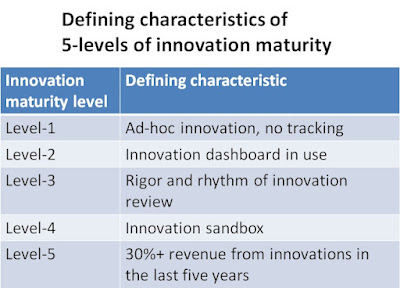Eight years ago, we proposed a 5-level innovation maturity framework that can be used as a mirror to quickly assess the innovativeness of an organization and help the managers in deciding a future course of action. Earlier this year, I wrote about the level-4 challenge and how organizations struggle to go from level-3 to level-4. In this article, I would like to take a step back and propose a defining characteristic for each of the five levels so that the assessor can generate an initial hypothesis about where the organization stands very quickly – say in five to ten minutes. This is an initial proposal and inputs are welcome.
[Level-2] Defining characteristic: Innovation
dashboard: Every organization that is serious about innovation, tracks it
in some form or the other. Of course, outsiders may not know it because
innovation dashboards are not published, unlike the accounting statements. Then
how do we know this? Well, over the last decade many organizations have begun
to publish a part of their innovation dashboard in the annual report. For
example, many listed companies in India like Voltas, Amara Raja Batteries (ARBL),
Titan, Mindtree, and TCS disclose various parameters of their innovation
dashboard under the section titled “Intellectual capital”. A manufacturing
company like Voltas reports (AR2020-21) R&D centers, R&D strength, no
of new SKUs, and no of 5-star energy efficiency SKUs. Mindtree reports (AR
20-21) parameters like innovation hubs, centers of excellence, No of patents,
etc. And even for organizations like TVS Motors (AR 20-21) which doesn’t present
“intellectual capital” in a separate section, one can find parameters like “New
product launches”, R&D expenditure, and expenditure on technology imported
in the last 3 years etc.
I feel a good innovation dashboard should have indicators
for pipeline
(small, medium, big bets), velocity
(e.g. experiments, champions, hackathons, reviews, dedicated teams), and
business impact. It should be a combination of process (e.g. hackathons,
reviews) and outcome (no of ideas, prototypes, revenue, saving) parameters.
The main point is a simple innovation dashboard is a
defining characteristic of level-2 innovation maturity.
[Level-3] Defining characteristic: Rigor and
rhythm of innovation review: You could use an innovation dashboard like a
status reporting tool for years. And that might not be very effective. The question is what kind of decisions and resource allocations are you doing after
reviewing your dashboard and innovation projects?
Over the past decade, I have had the opportunity to sit
through a number of innovation reviews. Moreover, I have had discussions with
many executives on how they conduct an innovation review. Good innovation
reviews are rigorous despite the uncertainty surrounding various aspects like
feasibility, desirability, scalability and viability. It questions the speed
and quality of hypothesis testing. As Ken Kocienda, the father of auto-correct
feature in iPhone points
out in the book “Creative selection”, Steve Jobs used to review prototypes
of major features himself. And Ken gives a detailed account of how such a
review happened in the book. Jeff
Bezos’ big bet review seems to be rigorous and yet mostly doesn’t involve
return-on-investment language and cash flow projections.
If I were to pick only one thing to observe in the
organization to gauge its innovation maturity, I would choose an innovation
review. It reveals management seriousness based on who attends, the clarity (or
lack thereof) on strategic challenges, showcases key innovation projects along
with their champions and experiments, and kinds of questions asked, and reveals
the commitment through resource (re-) allocation.
[Level-4] Defining characteristic: innovation sandbox:
In our book “8 steps to innovation”, we identify three big bet enablers:
innovation sandbox, platforms and open innovation. However, if I were to pick
one big bet enabler, I would pick innovation sandbox.
Innovation sandbox: Unlike a lab that can start with
a technology focus, a sandbox needs 3 to 4 constraints within which the
experimentation capacity is to be built. For example, having an Artificial
Intelligence lab is not enough. It needs to be combined with a strategic
challenge area relevant for the company such as healthcare diagnostics for a
broad customer category such as hospitals or end-consumers but typically not
both. An innovation sandbox combines
strategic focus, experimentation capacity, and dedicated resources, all are
crucial for big bet incubation. Amazon Go sandbox was built around image
recognition and cashier-less offline retail idea while Alexa sandbox was built
around speech recognition, display-less, cloud-connected personal assistant
idea.
Many companies such as automobile, aircraft, and phone
manufacturers and many technology companies have product platforms. These are
used mostly to churn out newer product variants at a faster pace. They are
valuable for variant generation at a faster pace. However, I wouldn’t consider
them big bet enablers. Creation of a new platform would need a sandbox focus. Facebook
has been a super successful platform. However, most of their subsequent big
bets like WhatsApp and Instagram have been acquisitions. I am sure their most
recent big bet Metaverse would have needed a lot of strategic focus and
experimentation.
Sandbox
hesitancy hypothesis says that management tends to be hesitant in building
a sandbox due to their inability to identify those 3 to 4 constraints and
commit resources to build experimentation capacity.
[Level-5] Defining
characteristic: 30% revenue from innovation in last 5 years: Philips annual
report in 2020 mentions that “Around 60% of revenues from new products and
solutions introduced in the last three years” under the “intellectual capital”
section. Instead of revenue, a company
may look at growth contribution from innovation. For example, 3M mentions in its
2020 annual report that “For the full year, our priority growth platforms grew
7%, outperforming the markets they serve.” These priority growth platforms
include indoor air quality, biopharma filtration, and automotive electrification
from a list of close to 50 platforms that it has developed.

No comments:
Post a Comment